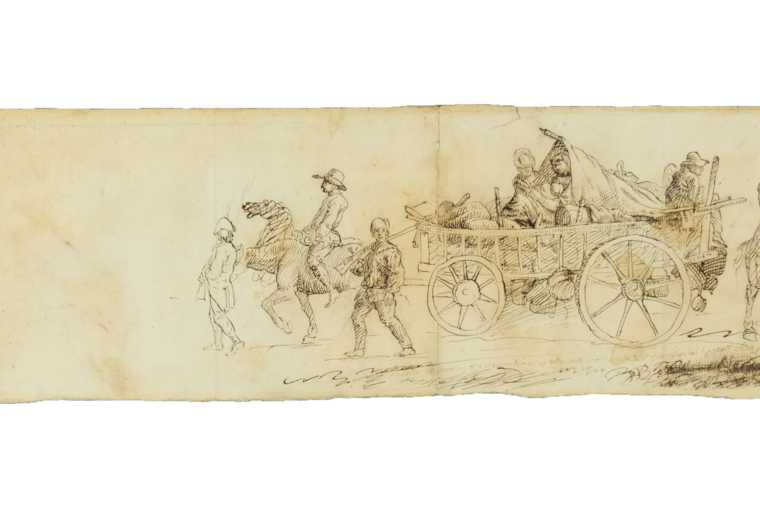How a curator at the Museum of the American Revolution solved a nearly 250-year-old art mystery
An eyewitness depiction of the Continental Army passing through Philadelphia hung in a New York apartment for decades. Now, it’s part of the Museum of the American Revolution’s collection.

Art collector Judith Hernstadt knew that she was looking at something special. It was the mid-1970s and she was buying a batch of sketches from a New York antiques dealer. One charming 18th-century drawing caught her eye. It was a rare depiction of women with a mysterious inscription partially torn off: “An exact representation of a waggon belonging to the north carolina brigade of continental troops which passed thro Philadelphia august done by…”
The illustrator was unknown, but the dealer said the work came from a home in Cherry Hill that once belonged to a doctor who treated artists during the Revolutionary War. It turned out that the sketch contained enormous historical significance as one of maybe a dozen eyewitness depictions of the Continental Army that still exists; even rarer was its portrayal of women camp followers, the lesser-known group that joined their enlisted husbands or fathers on the road and helped with cooking and cleaning.
For some 40 years, it hung in Hernstadt’s bedroom on the Upper East Side. Though many curators visited and found other treasures in her collection, that specific sketch did not resonate much until Matthew Skic came by last August — his jaw dropped the moment he laid eyes on it.
The curator of exhibitions at the Museum of the American Revolution, Skic immediately recognized the garment worn by one soldier as an American hunting shirt, a distinctive clue supporting the inscription. If authentic, the sketch would be only the second known depiction of women camp followers, and the first showing Continental troops from North Carolina.
“Alarm bells were just going off in my head — this is incredible,” Skic said. “There were just a lot of ideas circling in my head, that this is indeed real, this is indeed, probably, an eyewitness sketch, just who was the artist?”
Hernstadt, energized by Skic’s enthusiasm, allowed the curator to take the work to Philadelphia, where he consulted a handful of experts to investigate the artist and confirm that the sketch was legitimate. Within weeks, he examined it with Philadelphia paper conservator Corine McHugh, who agreed that the ink, paper, and handwriting aligned with the Revolutionary War period. He tracked down newspaper articles that placed the North Carolina Brigade in Philadelphia on Aug. 25, 1777, on its way to meet George Washington’s army to fight in the Battles of Brandywine and Germantown that fall.
Using handwriting analysis and comparisons to other works, Skic, his coworkers at the museum, and other art experts confirmed the artist was Pierre Eugène Du Simitière, a Swiss artist who moved to Philadelphia in 1774 and often drew scenes from the American Revolution.
Thrilled with Skic’s research, Hernstadt decided to donate the drawing to the museum. She had an appraiser assess its value but did not disclose how much it’s worth today. “Matthew brought great insight to it. It’s been a joy to work with someone who is enthusiastic and so scholarly,” said Hernstadt, who is eager to see the sketch shown at the museum and appreciated by American Revolution history buffs.
One group particularly interested in this history is the North Carolina Society of the Cincinnati, based in Raleigh, N.C., and composed of descendants of Continental officers from North Carolina. They contributed funds to conserve the sketch and give it a new frame. Skic says the museum will display the drawing in the near future.
Du Simitière’s work captured the North Carolina Brigade’s rule-breaking: Around this same time, Washington had issued an order that women were not allowed to ride in wagons (he considered camp followers a “clog” to the Continental Army’s movements, according to Skic). So it’s likely Washington would have disapproved of the sketch showing two women, one with a baby, riding in the wagon on that day in Philadelphia. (On the back of the drawing were sketches of men fighting.)
“What this kind of sketch helps us do is see the army in a new way and help us further realize that this is a diverse army in terms of personnel and skills and contributions needed for its success,” said Skic, who is still researching how the drawing wound up in Cherry Hill. “The decision to follow the army for women was a difficult one. [Some] didn’t have too many options available to them, because many of the women who are following the army are not very wealthy.”
By 1777, there were an estimated 2,000 women marching with American troops. It was often poor farmers’ wives and daughters , unable to sustain themselves in the men’s absence. They washed and repaired soldiers’ uniforms, tended to their wounds, and sold food to make a little coin. Though they were critical contributors to the war, women camp followers remain an under-examined part of Revolutionary War history, considered “forgotten revolutionaries.”
There exists only one other known eyewitness depiction of women camp followers. A panoramic watercolor painting of an encampment in West Point, N.Y., by Pierre Charles L’Enfant, the French engineer who designed Washington, is in the Library of Congress’ collection. It illustrates a woman holding up a kettle of food for soldiers to eat from.
Now, thanks to Hernstadt and Skic, it’s not the only one.